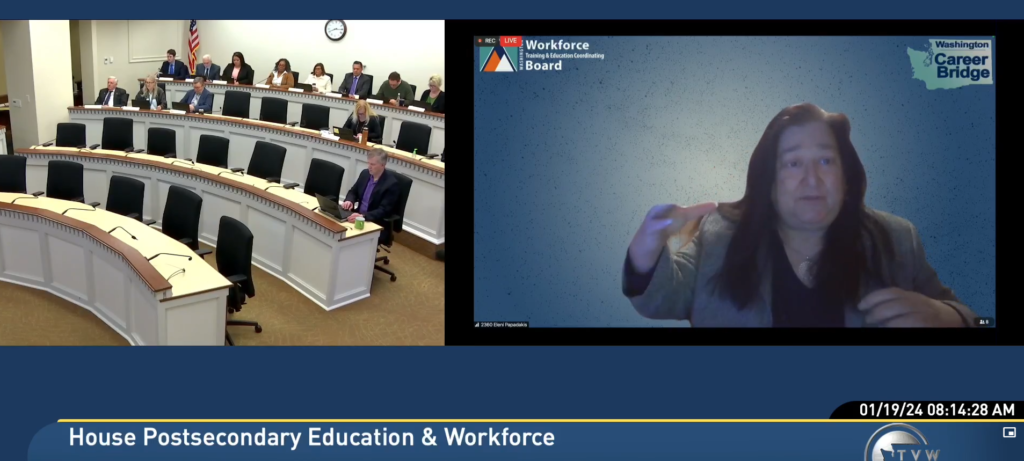Creating opportunity: Bridging the digital divide for Washington’s Workforce
Overview
Many marginalized communities in Washington face barriers to accessing quality jobs in the digital economy due to a lack of affordable and reliable internet, devices, skills, and support. This divide disproportionately affects the participation and opportunities of vulnerable groups. Closing this divide and creating new opportunities for living wage jobs is a major goal of the state strategic workforce plan, Talent and Prosperity for All.
The Workforce Board and partners completed several projects to advance this effort in June 2025. With initial one-year funding provided by the 2024 Legislature, several components of the initiative were able to launch and are now positioned as a foundation upon which future support may be built. Please note the reports section for more details.
The Workforce Digital Pathways Initiative involves public, private, state and local partners working together to narrow the digital divide through expanded or enhanced career pathways leading to good jobs.

Executive Director Eleni Papadakis, left, speaks to the House Postsecondary Education and Workforce Committee about the Workforce Digital Pathways Initiative.
Solutions include digital literacy education and credentials, rapid response skills gap programs to support training for new jobs created from federal infrastructure investment grants, work-based training and supports, and career readiness resources and tools. This is a broad effort among many partners to narrow the digital divide by increasing digital literacy among disadvantaged and marginalized populations and enhancing training and education pathways to good IT-related or IT-enhanced jobs.
Progress
The following bodies of work concluded in July 2025:
Washington State Digital Literacy Curriculum and Credential
WSU Global provided preliminary work to inform the design and development of a Washington digital literacy credential program. This included a digital literacy education and training landscape analysis and as well as gap analysis. A comprehensive preliminary report was submitted to the legislature in June 2025.
Reentry Services Support Program
This reentry services support program aimed to eliminate obstacles to economic success and reduce recidivism rates for individuals reentering society after incarceration in Washington’s corrections system. The focus of this program was in preparing incarcerated individuals for IT-Based, IT-enabled, or IT-adjacent jobs proliferating across our state, or for training and education that will lead to these jobs. The goal of this program was to not only make strides towards bridging the digital divide but also to expand the workforce pipeline. A Port Angeles based company, ETA Media Inc., carried out this project as a result of a formal RFP process. A 12 student pilot program at Washington Corrections Center concluded in July 2025.
Occupation and Education Mapping Tool
A preliminary feasibility study was conducted to explore what would be needed to garner support for and build a comprehensive platform tailored specifically for individuals pursuing careers in IT and IT related occupations. As industries evolve and new technologies emerge, job seekers, workers, and students are seeking accessible resources to navigate their IT and IT adjacent career paths effectively. The unique nature of this tool centers around the premise that it would gather data directly from industry through periodic polls, ensuring ongoing communication with training and educational institutions, workforce partners and industry associations. The project, if funded further, would leverage existing systems like Washington State’s Career Bridge and the Washington Health Workforce Sentinel Network, with a focus on IT and adjacent careers.
Background
In 2024 the Legislature funded these components of the initiative:
- Washington State Digital Literacy Curriculum and Credential – $425,000
- Reentry Support Program – $350,000
- Occupation and Education Mapping Tool – $150,000
- Administration and Partner Coordination (Dashboard not funded) – $150,000
Strategies
The Workforce Digital Pathways Initiative includes many strategies. Some were funded in 2024. Others were proposed in 2025 but not funded. Strategies include:
- Washington State Digital Literacy Curriculum and Credential (Multi-Tiered Digital Literacy Program) (funded in 2024)
- Rapid Response Skills Gap Programs (flexible fund pool) (proposed in 2025)
- Work-Based Training and Supports
- Advance Equity in IT Careers (AEITC) (proposed in 2025)
- IT Service Corps (proposed in 2025)
- Career Readiness Resources
- Reentry Support Program (funded in 2024)
- Devices for Job Seekers and Career Advancement (proposed in 2025)
- Occupation and Education Mapping Tool (feasibility study funded in 2024)
- Administration and Partner Coordination
- Performance Dashboard (proposed in 2025)
- Industry Advisory Council (funded in 2024)
- Contracts and Interagency Agreements, Compliance and Oversight (funded in 2024)
This initiative was developed using cost-effectiveness guidelines. Programs leverage or build upon current structures or resources whenever possible. Additionally, solutions are evidence-based, and performance accountability will be transparent and meaningful to meet goals and objectives.
For more information, please contact Career Pathways Policy Associate Paulette Beadling.

